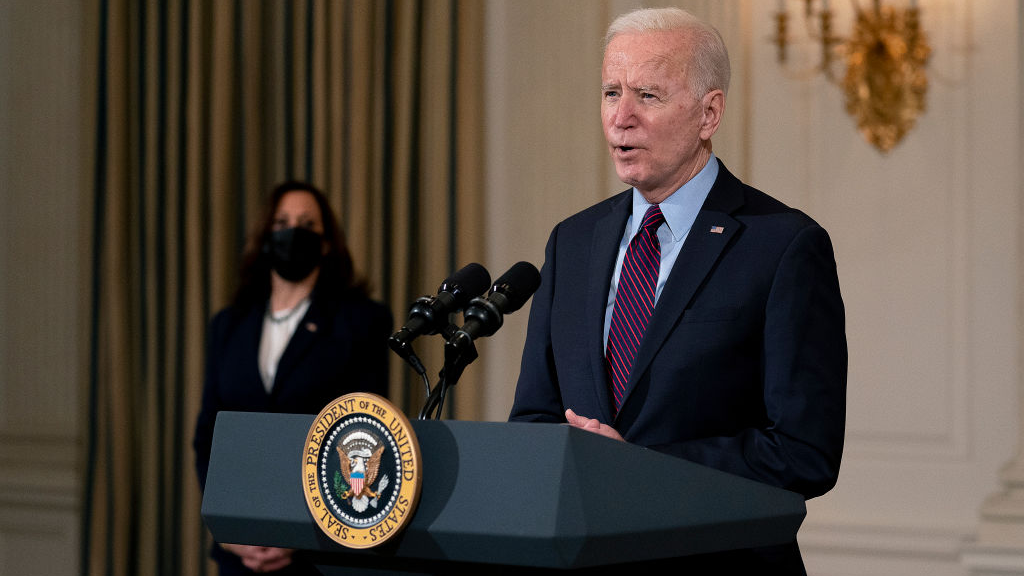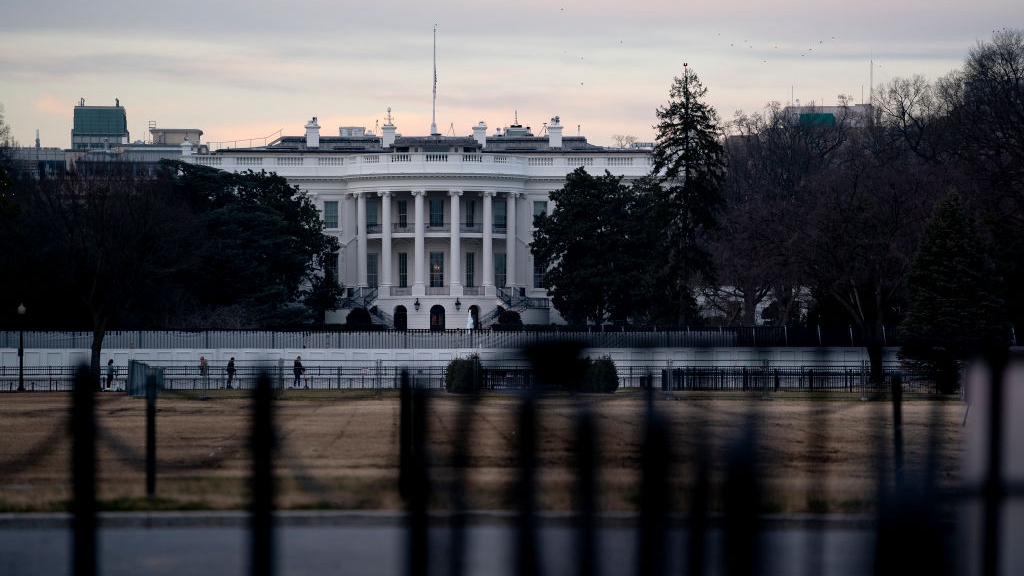
U.S. President Joe Biden delivers remarks on the national economy and the need for his administration's proposed $1.9 trillion coronavirus relief legislation, flanked by Vice President Kamala Harris in the State Dining Room at the White House, Washington, D.C., February 5, 2021. /Getty
U.S. President Joe Biden delivers remarks on the national economy and the need for his administration's proposed $1.9 trillion coronavirus relief legislation, flanked by Vice President Kamala Harris in the State Dining Room at the White House, Washington, D.C., February 5, 2021. /Getty
Editor's note: Koichi Hamada is Professor Emeritus at Yale University, was a special adviser to former Japanese Prime Minister Shinzo Abe. The article reflects the author's opinions and not necessarily the views of CGTN.
U.S. President Joe Biden's proposed $1.9 trillion pandemic recovery plan has been welcomed by many, especially on the left, who argue that such an ambitious, well-targeted strategy is precisely what this moment demands. Not surprisingly, many on the right oppose it, ostensibly over concerns about fiscal sustainability. But questions are also being raised by one high-profile Democratic stalwart: Lawrence H. Summers.
Summers is no stranger to stimulus. After the 2008 financial crisis, President Barack Obama appointed Summers – who had served as Treasury Secretary under President Bill Clinton – to head the National Economic Council to advise Obama on how to respond. Recognizing the importance of fiscal policy during crises, Summers was involved in crafting the American Recovery and Reinvestment Act (ARRA) of 2009.
Yes, that stimulus package ended up costing just $831 billion – less than half of what Biden is proposing. But, since then, a consensus has emerged among progressive economists that the economy would have been better off if the ARRA had been much bigger. Summers, who once cautioned the Obama administration against going too big, now says he agrees with that consensus.
And yet, for Summers, that example only strengthens his argument that the Biden proposal goes too far. In 2009, the gap between actual and potential output was about $80 billion per month and rising. While the output gap reached similar levels last year, Summers notes, it is now declining. According to the Congressional Budget Office, the monthly gap should fall from about $50 billion in early 2021 to $20 billion by year's end – without any new stimulus.
Given this, Summers argues that Biden's plan is at least three times larger than necessary. Moreover, he believes that the current policy discussion has "not fully reckoned" with the magnitude of the risks this raises, including the possibility of a rise in inflation, which he rightly notes would impede the execution of Biden's broader economic agenda.
In a recent discussion with Summers, however, Paul Krugman highlighted the uncertain nature of inflation predictions. What is certain, he noted, is that paring down the stimulus package today would have serious consequences for Americans who are struggling during the pandemic.
Those are not the only weaknesses in Summers' case. For starters, he assumes that what the U.S. economy is facing today is a demand shortage. But the situation is much more complicated than that. Restaurants and airlines are suffering not because consumers do not want their services, but because using their services has become unsafe or even prohibited.
So, if the Biden administration is to spur economic recovery, it will need to make it safe to spend again. Doing so will cost more than simply boosting demand for goods and services would. It may also take time, which is why additional financial support must be provided to those who need it in the interim.

The White House in Washington, DC, January 11, 2021. /Getty
The White House in Washington, DC, January 11, 2021. /Getty
The real-world impact of relief – such as the $1,400 stimulus checks the Biden plan would give most Americans – is also more complicated than Summers seems to think. If people receive a one-off payment to help them cope with a crisis that has no clear end date, they will not spend it as freely as if they received a permanent wage increase. Given this, as Krugman pointed out, a direct comparison between the output gap and the stimulus is misleading.
In discussing the importance and feasibility of fiscal spending, however, both Krugman and Summers missed an important opportunity to address the intellectual elephant in the room: modern monetary theory (MMT).
Biden doesn't subscribe to MMT in the way, say, Senator Bernie Sanders does. (One of Sanders' economic advisers during his 2016 presidential campaign was Stephanie Kelton, a prominent exponent of MMT.) And central bankers would never endorse MMT, because it blurs the distinction between monetary and fiscal policy.
Yet, in any discussion about government finance, MMT can provide fundamental insights – beginning with the fact that governments that issue their own currency do not really go bankrupt. Countries could, however, face inflation, balance-of-payments difficulties, or exchange-rate depreciations.
MMT has weaknesses. The theory suggests that if labor is "assigned" to the labor force, then the employment objective will be achieved even without using price or wage mechanisms. Perhaps Krugman's and Summers' messages could have been more clearly understood if they stated their views of MMT's fundamental position explicitly.
Both Biden and Krugman – as well as Treasury Secretary Janet Yellen, who also supports the stimulus proposal – surely understand that a record-breaking spending package risks fueling inflation. But, for them, the immediate welfare of displaced workers is the top priority. Summers, for his part, is more concerned about getting Biden's broader economic agenda implemented – and that will be very difficult if interest rates rise.
While Summers may be overstating the inflation threat, a careful review of Biden's plan along the lines he proposes is probably a good idea. Ultimately, however, policymakers will have to decide what risks they are willing to take to help the millions of Americans facing unemployment and hunger.
Copyright: Project Syndicate 2021.
(If you want to contribute and have specific expertise, please contact us at opinions@cgtn.com.)

